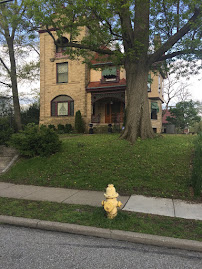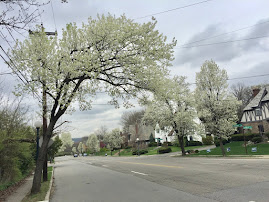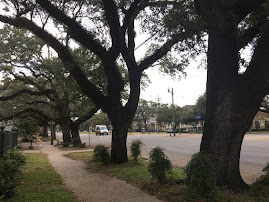Menominee
County Courthouse (1875)
Dear George,
There’s such an abundance
of information available online about the early years of my hometown of
Menominee and other Upper Peninsula Michigan communities. Lately I’ve been interested in tracking
down biographical information about Menominee’s lawyers from about 1850 to
1910. My dad spent his career as
a lawyer in Menominee, and several
of his good friends stemmed from family lines that went back two or three
generations of lawyers locally.
The times were so
drastically different in the 1800’s, and consequently people’s lives were
drastically different too. In 1850
the area that was to become Menominee and Marinette was largely a
wilderness. The Menominee River
logging industry was just getting its start. The first frame house in what was to later become the
village of Menominee was constructed in 1852. In 1859, when Eleazor S. Ingalls, Menominee’s first lawyer,
settled across the river in Menekaunee, the population of Menominee County was
only 500 people, most of them men working in logging camps. By the 1890’s, however, Menominee and
Marinette had become the world’s largest logging center, and Menominee County’s
population had grown to over 25,000.
As you’ll see from the biographical information below, Menominee’s early
lawyers played significant roles in the community’s growth.
I think that I’ve
identified most or all of the lawyers that practiced in Menominee between 1860
and about 1900. For some there’s
very little information available, and for others there’s a lot. Alvah Littlefield Sawyer’s
comprehensive work, “A History of the Northern Peninsula of Michigan and its
People” (1911) is a particularly rich source, as is the “Memorial Record of the
Northern Peninsula of Michigan” (1895), published by the Lewis Publishing
Company of Chicago. I’ve provided
summaries for the various individual lawyers, but there are often further
details available in the original references (see numbers in parentheses for
sources listed at end).
Love,
Dave
Judge
Ingalls
Judge Eleazer S. Ingalls
Eleazer Stillman Ingalls
was the first lawyer in Menominee County.
He was born at Nashua, New Hampshire in 1820. At age 18 he left
New Hampshire for Chicago, driving by ox team and accompanied by another
teenager. Ingalls settled at Antioch, Illinois, where his father was a
farmer. Eleazer learned blacksmithing in Nashua and studied law, eventually
entering practice in Antioch. He married his childhood sweetheart, Martha
Maria Person, in 1844, and they subsequently had three boys and five
girls. Only three survived to 1911 including Mrs. Alvah L. Sawyer of
Menominee. The same year that he married, Ingalls, at age 24, founded one
of the earliest newspapers in the Midwest, “The Prairie Hen, Jericho Jingle,
Land of Nod Loophole and Antioch Pill.”
It sold for $1.50 per year.
In 1850 Judge Ingalls organized a caravan and crossed the plains with a
caravan of four horse teams to California. After two years there he
returned east with a plan of bringing his family back to the Gold Rush.
However, he changed his mind, and in 1859 he arrived at the Menominee River on
the steamer Fannie Fisk, pitched his tent in Menekaunee on the Wisconsin side
of the river, and after a few days was “fully satisfied that Menominee had a
bright future” (Ingalls, 1876). In
1862 he moved across the river to Menominee, built a small house in the woods
that was later to become the village, and quickly became a prominent member of
the community. Menominee County had a total population of 496 persons in
1863, most of them engaged in logging and living in logging camps. There was an effort to establish a
county seat a few miles from Menominee and have the county known as County
Bleeker. Ingalls was sent to Lansing, and he vigorously fought and
defeated this attempt, establishing Menominee as the county name. The original town of Menominee was the
size of the state of Rhode Island, sixty-one miles long and thirty miles
wide. Ingalls was the first Judge
of Probate in the new county, serving in this position for several years. He also started the Menominee Herald in
1863 (later the Herald-Leader) and was its first editor, the early issues being printed with a
hand press. Ingalls was active in
railroad construction interests, and he secured a contract from the state to
build the Green Bay and Bay De Noc State road within Menominee County. He was instrumental in obtaining state
funding for the first bridge across the Menominee River. Ingalls built and operated two
saw-mills on the Menominee River, both of which were destroyed by the Peshtigo
Fire in 1871, and he played a major role in extending the Menominee branch
railroad to the Iron Range. Shipments of iron ore were begun in
1878. Judge Ingalls was a member of the Constitutional Convention of
Michigan and was a Representative in the State Legislature. According to his biography, Judge Ingalls "was very
widely known and universally respected." Ingalls wrote a history of Menominee County called
“Centennial History: and published in 1876. He died in Menominee on Nov. 1,1879, at the relatively young
age of 59, and is buried in Riverside Cemetery. The community of Ingalls in Menominee County is named after
him. Judge Ingalls’ daughter
Josephine, who married Alvah Littlefield Sawyer, was the grandmother of my
father’s Menominee law partner, Richard A. Sawyer. (3, 6, 8, 11, 14)
Thomas B. Rice
Thomas Rice was the second
lawyer to come to Menominee. He
was born in Franklin County, Vermont, in 1842, He began his legal studies in Glens Falls, N.Y., in 1858,
and he graduated from the Albany University Law School on March 4, 1864. He conducted a law practice in Morris,
Ill., for two years, then practiced in Aurora for two years, and as a clerk in
the Chicago law office of Higgins, Swett & Quigg for three years. In 1871 Rice came to Menominee, where
he established his practice in the Post Office Block on Main Street. Rice was the Menominee Prosecuting
Attorney for four years and then Judge of the Probate Court for eight or more
years. (4)
Benjamin J. Brown,
Prosecuting Attorney
Benjamin Brown was born on
July 8, 1833, at Mt. Vernon, Ohio. His grandfather was a builder of the Ohio
canal. His father, Benjamin S. Brown, was an eminent lawyer and highly
regarded orator who was a partner of a Justice of the U.S. Supreme Court.
Brown was educated at the Sloan Academy in Mt. Vernon, spent a year at Kenyon
College, and was admitted to the practice of law by the Supreme Court of
Illinois in 1855. After stints in Chicago, Green Bay, and Oconto, he
moved to Saginaw and joined the Michigan Bar. He and Eliza Hart of Oconto married in 1862, and the couple
had seven children. Brown came to
Menominee in 1873 where he spent the major part of his professional life.
As of 1876, his office was on Brown’s Block at the corner of Main and Quimby
Streets. Brown was a leading
member of the bar in Menominee County and was well known throughout the Upper
Peninsula. He served as City Attorney of Green Bay and Prosecuting
Attorney for Menominee County. He took many cases to the Michigan Supreme
Court where he was deeply respected.
Brown died at Menominee on Jan. 9, 1905. His lawyer biographer
says, "Resolved, that the Bar of Menominee County, whose members have been
associated with Mr. Brown so long and so pleasantly in the labors of the
profession, and in the duties and responsibilities of a common citizenship, and
who from their association with him have learned to respect, admire and love
him, deploring his loss." (6, 13)
William A. Franklin
William Franklin came to
Menominee in March of 1876, and he and E.S. Ingalls formed a partnership that
year. The Ingalls and Franklin law
office was located on Main Street near Ogden Avenue. (11)
Lewis
D. Eastman
Lewis D. Eastman was born
on Oct. 18, 1851, in Lisbon, New York, one of nine children of Reverend Morgan
L. and Hester (Thorpe) Eastman.
Rev. Morgan's family was of English origin and traced back to the colonial
days in New England. The family
moved to Royalston, Wisconsin, in 1868, where Lewis continued his education in
the public schools. He graduated
with his Bachelor of Laws degree from Northwestern University in 1888 and was
admitted to the bar. He moved to
Menominee in 1889 where he served four terms as city attorney. He was appointed circuit-court
commissioner and completed two terms in that office. A. L. Sawyer (1911) observes that Eastman "has gained a
high reputation as a trial lawyer and as a counsellor well fortified in the
minutiae of the science of jurisprudence." Eastman married Clara Baker of Trumbull, Ohio, and, as
of 1911, they had three children, Evelyne, Sidney L., and Alice May. Eastman died on Aug. 11, 1927, and is
buried in Oakwood Cemetery, Lowell, Michigan. (14)
John Lane Buell
John Lane Buell was born to
Ann and George Buell at Lawrenceburg, Indiana, just outside of Cincinnati, on
Oct. 12, 1836. He studied in the Lawrenceburg public schools, then
attended the Norwich Military Institute in Vermont for two years. He
moved to Leavenworth, Kansas in 1857 and was one of a small band of youth that
were the first from there to travel overland for Colorado. The group
settled on the Platte River, near the present site of Denver, and Buell
surveyed and platted the present city of Boulder, then engaged in mining at the
present site of Leadville. In 1860 Buell travelled to New Mexico, then to
Texas which had seceded from the union. Escaping by night, Buell reached
the gulf and travelled by ship to New York City. In August 1861 he was appointed a second lieutenant in the
U.S. Infantry, stationed at Fort Columbus, New York. He took part
in the second battle at Bull Run and had command of two companies at
Antietam. He lost 13 of 27 men to rebel fire. After Antietam
Buell resigned from the army and returned to Lawrenceburg, serving in the
Indiana militia. He entered Harvard College in 1863, studying law for six
months, then returned to Lawrenceburg where he married Ruth B. Ludlow, the
granddaughter of the first sheriff of Hamilton County. Because of ill health, Mr. Buell sought
a change of climate and moved to Menominee in 1866. He practiced law for
five years in Menominee as opportunity allowed, operated the Jones mill on the
Green Bay shore, farmed, and published the Menominee Journal. In
1871 Buell visited the area later known as the Menominee Range and was the
first person to discover iron ore there, naming it the Quinnesec Mine. Buell founded the village of Quinnesec
and served as its postmaster, being paid about $300 a year. He was
elected to the state legislature in 1872, serving as the representative from
Menominee, Delta, Schoolcraft, and Chippewa counties for two years.
He introduced the first ten-hour labor bill ever submitted, as well as the
Marquette and Mackinaw Railroad bill. John Buell died at home on Oct. 24,
1916, at Quinnesec in Dickinson County in the U.P. (2, 14)
W.
H. Phillips
William H. Phillips
W. H. Phillips was born in
Lenawee County in southeastern Michigan, on Aug. 7, 1839. He worked on
his father’s farm there until age 21. As a young child he walked a mile
and a half through the woods to a little log schoolhouse where he sat on a
crude slab bench to do his lessons. In 1860 he went to Oak Grove academy
where he rang the bell and swept the building to pay his tuition. He
studied science at Adrian College for two years and studied law in his spare
time. Phillips and Amy R. BeDell
married in 1867, and the couple had two children, Etta and Harry.
Phillips continued his studies in a law office in Adrian and was admitted to
the Michigan Bar in 1879. After practicing for a year in Adrian, he moved
to Menominee and became partners with local lawyers named Weter and
Thompson. After three years, he practiced alone. In 1882 Phillips
was elected Prosecuting Attorney of Menominee County, and in 1888 he was
elected to a three-year term as City Attorney. In 1894 Phillips was again elected Prosecuting Attorney. He was also a member and Treasurer of
the Menominee School Board and President of the Menominee Gas Light & Fuel
Company. The family were members of the Presbyterian Church, and Phillips
was one of the most prominent Masons in the state, serving as the first King
and as High Priest of the Menominee Chapter for three years. His
biographer notes, “Few citizens of Menominee are better known or more highly
respected than is W. H. Phillips.”
Phillips died on Feb. 13, 1906, and is buried in Riverside
Cemetery. (2, 6)
Byron Sylvester Waite
Byron S. Waite was born at
Penfield in Monroe County, New York, on Sept. 27, 1852. His ancestors had
settled in Massachusetts from England during the colonial period. The
family moved to Livingston County in Michigan 1n 1856, and Byron grew up there,
doing farm work and attending the public schools. He graduated from the
Baptist Seminary at age 18, then was the principal of public schools at
Rochester, Michigan, saving money for college. He entered the Literary
Department at the University of Michigan in 1876 and graduated with his B.A. in
1880. He sawo attended Law School lectures and read the required
textbooks. Waite was admitted to the Bar at Ann Arbor in 1879. He
became a junior partner in a law from in 1881 in Wayne County, then moved to
Menominee a year later and became joined a partnership with Alvah Littlefield
Sawyer in the firm Sawyer & Waite. Sawyer & Waite was the largest
and most lucrative law firm in Menominee at the time, and they argued important
cases at the Supreme Court of Michigan. Waite was Circuit Court
Commissioner and United States Commissioner at Menominee in 1884-85, and he was
elected as Menominee County's representative to the State Legislature in
1888. He was highly popular and regarded as an important leader in the
Legislature. His partnership with Sawyer continued for thirteen years
until 1895, whereupon Waite accepted a position as Assistant Prosecuting
Attorney of Wayne County and moved to Detroit. He was a Circuit Judge from 1898 to 1900, and, appointed by
Theodore Roosevelt, was a judge for the United States Custom Court from
1926 to 1930. One of his
judicial colleagues wrote: "Byron S. Waite is considered one of the
brightest lawyers that ever practised in the Northern Peninsula...As a citizen
he is public-spirited, and while at Menominee was constantly endeavoring to
advance the interests of that city." Byron Waite died at home in
Yonkers, New York, on Dec. 31, 1930.
(9, 13)
A.
L. Sawyer
Alvah Littlefield Sawyer
The first American
representatives of the Sawyer family arrived from Birmingham, England, in 1648,
initially settling in Massachusetts. Alvah Sawyer’s father Hiram and his
wife Barbara moved from New Hampshire to Dodge County, Wisconsin, in 1845,
becoming among the earliest pioneers in the area. Hiram Sawyer was a farmer and elected member of the
Wisconsin legislature. They had twelve children, including three who came
to live in Menominee: Mary S. Childs, Ransom, and Alvah (the fourth son).
Alvah studied law in his brother's office at Hartford, Wis., was admitted to
the bar in 1877, and came to Menominee in 1878 to practice in the office of
Judge E.S. Ingalls. Sawyer married Miss Josephine S. Ingalls, daughter of
Judge Ingalls, on Apr. 13, 1880. The Sawyers had five children: Kenneth
I., Gladys, Meredith, Wilda, and Irma.
Sawyer and Byron S. Waite established a partnership in 1882, and, with
the addition of W. F. Waite, the firm expanded to Sawyer, Waite & Waite in
1893. When Menominee was incorporated as a city in 1893, Sawyer was
elected city attorney, a position he held for five years. Sawyer was also a member of the
Menominee school board, president of the Spies Library Board, chairman of the
Democratic county committee, secretary of the Shuswap Lumber Co., was involved
in U.P. mining operations, in farming, and was an expert horticulturist with a
passion for flowers. Sawyer authored the three volumes of “The
Northern Peninsula,” a comprehensive history of the U.P., and his wife
Josephine, a prolific writer in her own right, collaborated with him on those
works. G. I. Reed (1897) wrote:
"Mr. Sawyer is a man loyal to all community in which he lives,
enterprising and active in support of all measures of a character to advance
the general interests and welfare...His beautiful home (at 1701 State St.) is
adorned with works of art and furnished with one of the finest private
libraries in Northern Michigan...His wife joins him in the entertainment of
friends and the exercise of a liberal hospitality." Alvah Sawyer died in Menominee on Feb.
5, 1925, and he is buried in Riverside Cemetery. Alvah Sawyer was the paternal grandfather of my father’s
Menominee law partner, Richard A. Sawyer.
(2, 6, 8, 13)
Michael J. Doyle
Michael J. Doyle was born
in Memphis, Tennesse, on Oct. 1, 1854, the son and only child of William and
Bridget Doyle, both natives of Ireland. William Doyle, a
contractor, died at 32, and Bridget Doyle died in childbirth at 28.
Michael studied at De LaSalle Institute and Osgoode Hall in Toronto, graduating
from the latter with his Bachelor of Law in 1879. He first practiced in
Detroit (1879-1887), then moved to Sault Ste. Marie (1887-91), Iron Mountain
1891-94), Menominee (1894-97), and Green Bay (1897-1903). He represented the Chippewa District in
the Michigan state House of Representatives in 1891-92. He returned to Menominee in 1903.
He was elected prosecuting attorney of Menominee County and served for two
terms (1906-1910). He was chosen as chairman of the state Democratic
party in 1909, and he was elected Mayor of Menominee in 1918. He was also president of the Menominee
school board for two terms, custodian of alien property in northern Michigan,
city attorney for Menominee and Iron Mountain, and supervisor of the U.S. census
for Michigan’s twelfth district. He was a candidate for state Supreme Court
justice in 1922 and for Lieutenant Governor of Michigan in 1924. Doyle
married Marie Benedicta Fitzpatrick of Hamilton, Ontario, in 1880, and they
were the parents of seven children: Helen, Gerald, Gladys, Kenneth, Thurman,
Wilford, and Meredith. A talented author, Doyle published two works of
fiction, "Swan Swanson" (1895) and "John Poorfellow"
(1898). Michael Doyle died from heart disease at his home in Menominee on
July 2, 1928, and is interred at Riverside Cemetery. Doyle’s sons Kenneth, Thurman, and Meredith were Menominee
attorneys when my father began his practice there and were colleagues for
several decades. Michael J. Doyle
was the maternal grandfather of my parents’ close friend, Menominee attorney
and Michigan Supreme Court Justice Michael Daniel O’Hara. (7, 8, 10, 12, 14)
Fabian
Joseph Trudell
Fabian J. Trudell was born
in Green Bay, Wisc., on Dec. 29, 1859, the youngest of ten children of Olive
and Theodulph Trudell. The family
moved to Menominee about 1869, and Fabian attended the public schools
there. He worked as a printer for
the Menominee Herald from 1875 to 1878, sold farm implements in Minnesota for
one year, and worked for the Chicago & Northwestern Railroad Co. Having taken up law studies, he
returned to his parents' home in Menominee and entered the law office of
William H. Phillips. He then
graduated with a Bachelor of Laws degree from the University of Michigan in
1884, was admitted to the state bar, and became the first attorney in Iron Mountain. He became city attorney there, played a
central role in the incorporation of the village and the city, was Dickinson
County's first prosecuting attorney, and was elected to two terms as mayor of
Iron Mountain. In 1898 Trudell
returned to Menominee, forming a partnership with Benjamin J. Brown. He married Mary Josephine Foster of
Pennsylvania in 1889, and the couple had two daughters, Olive and
Margaret. A.L. Sawyer, wrote of
Trudell, "He controls a large and representative practice and is distinctively
one of the leading members of the bar of this section of the state. Trudell was appointed Menominee's city
attorney in 1907. He died in 1945
and is buried at Riverside Cemetery
(14)
William F. Waite
William Fuller Waite was
born in Tyrone, Michigan, in Livingston County on Aug. 4, 1860, the sixth in a
family of seven children. The family, of English descent, had settled in
Massachusetts well before the Revolutionary War. Waite attended school in the winter but worked on the family
farm the rest of the year. He
received his higher education in the Literary Department of the University of
Michigan, attending law lectures as well. He was admitted to the bar at
Howell, Mich., on Jan. 18, 1888, and, after prospecting for a while, he located
as Escanaba where he practiced law until April 13, 1893. He then moved
his practice to Menominee where he joined the firm of Alvah Littlefield Sawyer
and his older brother Byron S. Waite, the firm name becoming Sawyer, Waite
& Waite. He served as Prosecuting Attorney of Menominee
County and then as judge of the Municipal Court of the city of Menominee.
Waite married Miss Helen Osgood of Ann Arbor on Jan. 15, 1891, and the couple
had two sons, Leslie Osgood and Gordon Tarbell. Mrs. Waite was the class poet at Michigan. According to one biographical statement
(13), William Waite "has the care, the application, the disposition and
natural ability essential to success." Waite died at Menominee on Oct. 21, 1918. (13, 14)
John
Michael Opsahl
John M. Opsahl was born in
Christiania, Norway, on Feb. 7, 1863, the son of Michael C. and Louise C.
Opsahl. The father moved to
Menominee in 1870, and Opsahl, his sister Agens, and his mother joined Mr.
Opsahl in 1872. John Opsahl
attended public schools in Menominee, earned a Bachelor of Philosophy degree at
the University of Michigan, and matriculated in the department of law there as
well. He was admitted to the state
bar in 1886 and returned to Menominee to begin his law practice. Specializing in real-estate and
commercial law, Opsahl's Main Street office was "one of the finest and best equipped offices north of
Milwaukee" (Memorial Record, 1895).
In 1903 Opsahl married Anna Hansen, and the couple resided on Ogden
Avenue. Opsahl was elected
Circuit Court Commissioner for Menominee, justice of the peace, and municipal
judge. He was also secretary and
treasurer of the Menominee Land & Investment Co., an organizer of the
Menominee Electric & Mechanical Co., and U.S. Commissioner for the Western
District of Michigan. He was one
of the founders of Menominee's first military organization, the Third Regiment
of Michigan State Troops, in which he served from 1885 to 1887. He also organized the benevolent
association, "Sons of the North," to assist fellow Scandinavians and
was a prominent member of the Odd Fellows, the Knights of Pythias, and the
Uniform Rank. Opsahl died in 1925
in Contra Costa, California. (6,
14)
George Barstow
George Barstow of
Stephenson, Mich., was born on Sept. 6, 1882, in Algoma, Wisconsin, the third
of ten children of blacksmith Adolph Barstow, a Hungarian immigrant, and his
wife Margaret. Adolph Barstow came to Menominee County in 1886,
establishing his blacksmith trade there. George spent his summers as a
teenager in pound-net fishing, received LL.B. degrees in 1905 from Valparaiso
University and in 1906 from the Detroit College of Law, practiced in Detroit
and was admitted to the bar in 1906, and located in Stephenson in Menominee
County in 1907. According to A. L. Sawyer's (1911) account, he "is
fast winning for himself a lucrative practice and an honorable name in the
legal profession." Barstow married Bessie Woessner of Stephenson in
1909. He moved to Menominee in 1917, joining the firm of Doyle and
Barstow. Among other clients,
Doyle and Barstow were attorneys for the Bank of Stephenson, the Daggett State
Bank, and the Chicago and Northwestern Railroad. According to A.L. Sawyer, "Politically Mr. Barstow is a
sound Republican, and fraternally he belongs to the Menominee Lodge of Knights
of Pythias." George Barstow
died in 1960. He and his wife were the parents of Menominee lawyer
Steven Barstow, one of my father's friends and contemporaries, and it turns out
that the legal management of our family property in Menominee County continues
to be done by the firm founded in 1925 by George Barstow. (1, 14)
SOURCES:
(2) _____. Find a Grave, “John Lane Buell,”
“William H. Phillips,” “Alvah Littlefield Sawyer”. www.findagrave.com.
(3) _____. The genealogy and history of the
Ingalls family in America. www.archive.org.
(4) _____. History of Northern Wisconsin,
Containing an Account of Its Settlement, growth, development, and
resources. Chicago: Western
Historical Co., 1881. www.archive.org. (Menominee, pp. 601-611, with history and short biographies.)
(5) _____. The Ingalls Inquirer, “Ingalls in
America.” www.home.comcast.net.
(6) _____. Memorial Record of the Northern
Peninsula of Michigan, Chicago: The Lewis Publishing Company, 1895. www.quod.lib.umich.edu.
(7) _____. Michigan Biographies, Including Members
of Congress. www.icweb2.loc.gov.
(8) _____. Political Graveyard, “Doyle family of
Michigan.” www.politicalgraveyard.com.
(9) _____. Wikipedia, “Byron Sylvester
Waite.” www.wikipedia.org
(10) Burton, C.M., Stocking,
V., & Miller, G.K. (eds.), “The City of Detroit, Michigan, 1701-1922, Vol.
4. www.books.google.com.
(11) Ingalls, Eleazer S.
(1820-1879) Centennial History of Menominee County. Menominee, Mich.:
Herald Power Presses, 1876. www.books.google.com
(12) Moore, Charles (1855-1942).
The History of Michigan. Chicago: The Lewis Publishing Company,
1915. www.onlinebooks.library.upenn.edu.
(13) Reed, George Irving
[Ed.], Bench and Bar of Michigan: A Volume of History and Biography. Chicago:
Century Pub. and Engraving Co., 1897.
www.archive.org.
(14) Sawyer, Alvah
Littlefield. A History of the Northern Peninsula of Michigan and its
People. Chicago: 1911. www.quod.lib.umich.edu.





































































































































































































